Elliott Sailors is a professional model who has had a pretty successful career in the high fashion world, boasting time on the Ford board and appearances in Harper’s Bazaar, Cosmopolitan, Women’s Health, and this Icona Pop video, where she plays a judge at a drag ball.
A CHANDELIER ATTACKED MY HAIR / I DON’T CARE
About a year ago, Sailors got her hair cut short at her husband’s barbershop and started showing up at menswear casting calls. The look works well for her, and she was signed to Ford’s menswear roster. Last week, she received a flurry of press after a couple of “tell-all” interviews with the New York Post led to a bunch more interviews, articles, retrospective “transformation” photo galleries, and all the other stuff that tends to happen whenever someone in the public eye plays with gender even a little bit.
I’m not really concerned about why Sailors decided to work in menswear — I don’t know enough about the fashion world and its attendant pressures and prejudices to judge the merit or appropriateness of a pure career decision, and if the move is based in more personal gender-related feelings, then it’s absolutely not my place (or anyone else’s) to have an opinion. Her public explanations suggest a mix of both: she told the Post that she is “starting over to have a longer career,” because “men don’t need to look as young [as women],” but also said that although she has “never identified as a male,” she has a fluid interpretation of her own gender: “Who it is that I am is not limited to just being perceived as a female. Who it is that I am is inclusive also of what it is that is perceived as male. It’s a part of how I see myself.”
More interesting is how different news outlets privilege some explanations over others when telling her story — for the New York Post (and other mainstream outlets), “I did it for my career” is the lead argument, put front and center to legitimize the attendant “weirdness.” Meanwhile, queer and queer-savvy reporters apply the same hierarchy for different reasons — over at Slate‘s XX blog, Katy Waldman calls Sailors’s “stunt” “at best a canny career move… and at worst slightly insensitive to trans* people,” saying “there is no need to drape what is finally a perfectly pragmatic career decision in the drama of real-life gender reassignment.”
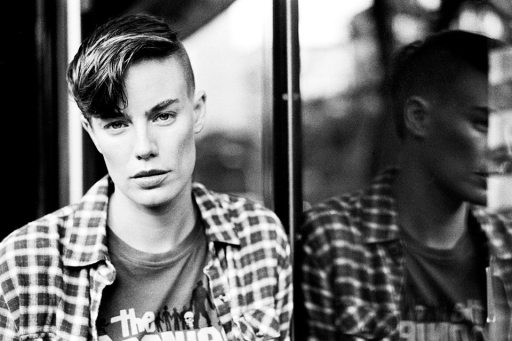
DRAHMA
This is true and valid (although Waldman’s article is also problematic in a lot of ways, which I’ll get to later). We live in a world where actual trans* people are denied equal rights, situationally and institutionally misgendered, and murdered for who they are (even within the mainstream queer community, trans* issues almost uniformly take a back seat). The media is a huge part of the problem, constantly othering trans* people by disrespecting pronouns, inappropriately focusing on private aspects of transitions, clinging to outdated and pathologizing narratives, and generally fucking up what is actually not a very hard thing to understand. To see the same news outlet that constantly traffics in anti-trans* slurs call a gender-bending haircut “brave” and “hot” when a model gets it is really disgusting, and speaks to just how much you can “get away” with if you’re white and pretty and don’t push TOO hard. And Sailors herself seems, unfortunately, unaware of the rich history of public and artistic gender play outside the modeling world — she positions herself as someone who is starting conversations that have been going on for quite some time in other arenas (i.e. “I want to make something else available and possible for people”), and though she cites Andrej Pejic and Omahyra Mota as inspirations, she has so far not mentioned other clear vanguards, such as Mykki Blanco, iO Tillet Wright, and somewhere around 40% of all metropolitan coffeeshop employees.
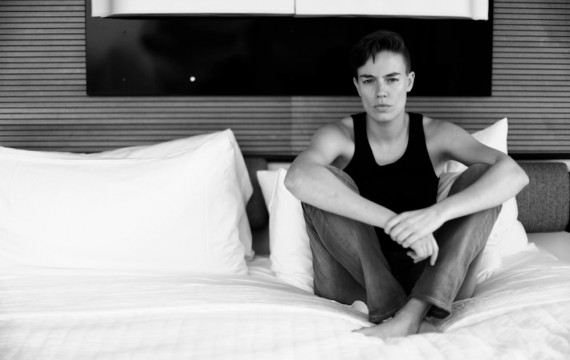
PLZ SEND COPIES OF JUDITH BUTLER TO THE PILLOW ON THE LEFT
At the same time, it’s hard to totally blame Sailors for the way people talk about her, or for the way she talks about herself. It’s easy to try—both are really appropriative and definitely problematic. First, and most frustratingly simple, is the way everyone insists on calling her a “male model.” Sailors is not a male model, she’s a menswear model. She is very clear about the fact that she continues to identify as a woman (a clarity that shouldn’t really be necessary; if cutting your hair, dressing in guy’s clothes, or anything short of identifying yourself as a guy made you a guy, my morning wardrobe choices would be a lot more fraught). And yet headline after headline makes this extremely basic mistake: a Google search for Sailors’s name yields “Gal finds success as male model“; “Female Model Turned Male Model” and “Lady Looks Like A Dude: Female Model Goes Male,” among others. Even a New York Magazine piece that is supposedly about Sailors addressing issues of trans* appropriation is titled “Female-to-male model Elliott Sailors Addresses Her Haters” (props to Allure, though, which got it consistently right).
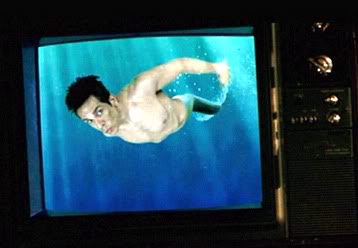
KIND OF LIKE HOW ZOOLANDER IS A MERMENSWEAR MODEL
The articles themselves are peppered with similar mischaracterizations, often right alongside the garden-variety female masculinity policing that we’ve come to expect (“She says her husband, Adam Santos-Coy, is supportive — although she was a jaw-dropping blonde when he married her”). And Elliott herself occasionally uses reductive language (“When I’m in an elevator, I notice that they let all of the girls go first — like the real girls”). Most of the articles also traffic in over-the-top statements of finality (“she would have to get her long hair cut off for good,” — it does grow back, Daily Mail) and conflate gender and sexuality like woah, whether explicitly (“Her movement into the male realm, she claims, is solely career-based rather than sexuality” – The Daily Beast) or implicitly, by emphasizing the fact that Sailors has a husband and that he’s cool with everything.
What’s at once the most heartening AND the most troubling about all this is that when Sailors is given the opportunity to speak freely and at length, she (besides the aforementioned slip-ups) doesn’t make these mistakes. In fact, she says consistently smart, aware, and interesting things about her own decisions and identity. In a video discussion on HuffPost Live, she talks about how she wants her choices to inspire people “to be free to express yourself in all of who you are—that you’re not limited to what you were at any point in time, that it’s possible always to continue to transform, and to find new forms of self-expression so long as they are authentic to you.” That’s a far cry from the “I cut my hair off forever and my skin is now grafted to this blazer” plotline that everyone else seems so eager to ascribe to her. She reiterates this in an interview with The Hairpin, saying that “who you are can be expansive; it can include many things. That’s what fashion is also about.” In the same interview, she elaborates on the new space she’s trying to create: “I’m not trying to be a man. But [in the modeling world], there’s menswear and womenswear. There isn’t an option for androgyny. I think that it’s totally possible that it will start happening… there will be something in between… it’s true that there are a number of places in between male and female.”
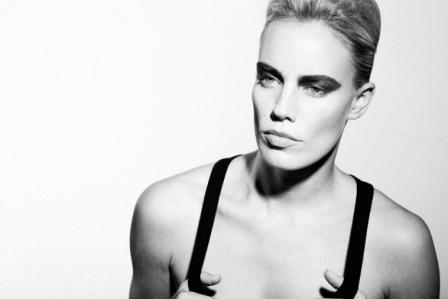
AND THAT MANY OF THOSE PLACES ARE MAD HOTT
What cool things to say! It literally put a smile on my face, reading those things. As a genderqueer person who is keenly aware of the sheer magnitude of the number of in-between places she’s talking about, and who struggles to find public figures who play with gender and don’t solidly align themselves with terms like “boi” or “butch” or “stud,” I’m also really cognizant of how few people take the time to say them. And in a world where alternative gender identity is constantly and instinctively linked to alternative sexuality, it’s especially cool to hear an avowedly straight woman talk about how a masculine presentation is “sort of just more me.” And yet no one pulls those quotes.
Even queer and queer-culture-savvy writers are fucking this up. After accusing Sailors of appropriating trans* experiences—still a fair criticism, though again, I’d blame the news more than the subject—Waldman goes for a weird groin-kick, saying,”My colleagues at Outward were also unimpressed—and not just because more than one of them thought the shorn Sailors still reads as female.” If you think about Sailors as someone who is keeping her cis privilege while cashing in on trans* stories, the cattiness radiating from this statement makes some sense. But if you think of her in the way she describes herself—as genderfluid or androgynous, even though she lacks the exact vocabulary queer people generally use to talk about these things—this is straight-up gender policing, and it’s uncalled for, rude, and erasing.
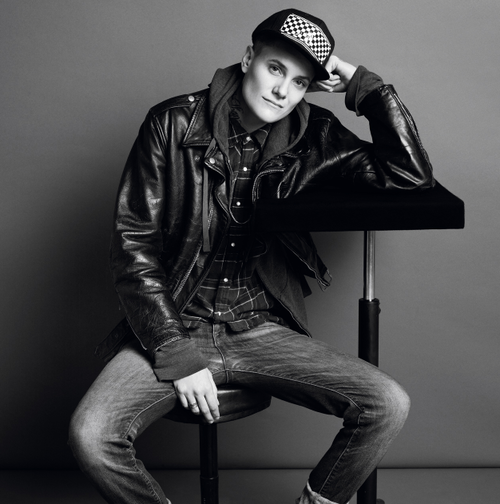
THIS IS CASEY LEGLER; PLZ READ THE NEXT PARAGRAPH IN HER VOICE, HOWEVER YOU IMAGINE IT
We’ve seen this before—earlier this year, Casey Legler made headlines (a lot of similarly incorrect and essentializing headlines, as a matter of fact) when Ford hired her for their menswear board. Legler didn’t go the New York Post route, and mostly got coverage in fashion- or queer-focused outlets, including this one. Perhaps because of this, she was slightly more successful in getting quoted talking about this in-between, or even outside, space:
“I understand signifiers. We’re social creatures and we have a physical language of communicating with each other. But it would be a really beautiful thing if we could all just wear what we wanted, without it meaning something… it would be a lovely place if we didn’t necessarily judge or jump to conclusions because someone wants to wear a dress or because someone wants to wear pants.”
(In a video interview with Time, Legler repeatedly describes herself as a “male model” but qualifies it with “that’s such a weird thing to say, because I’m a woman, you know?”). Erika Linder, who does both womenswear and menswear shoots, has gotten even less attention, maybe because her fluid presentation is too confusing for journalists to properly cover. But in one interview I found, she spoke about how her style changes: “One day it can be very feminine and the other day it can be really masculine. I don’t want it to be just [one way or the other]. I want to play with both as much as possible and keep a balance between them.”
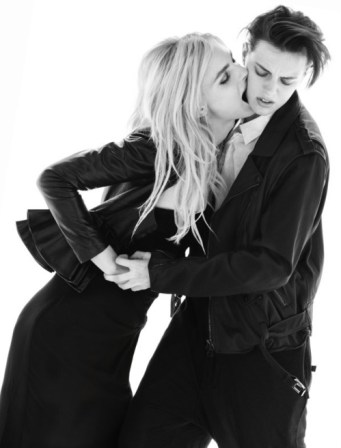
ANDREJ PEJIC & ERIKA LINDER; YOU’RE WELCOME
All of these models clearly and vocally identify outside of the gender binary. They are referred to with gendered language and stuffed into cookie-cutter “trans*” narratives — which, as Olivia has pointed out, don’t even apply to many people who do identify as trans* — not because this language and these stories actually describe them, but because our culture and our media don’t have the tools to deal with anything else. In a society obsessed with categorization — are you gay or straight? black or white? a girl or a boy? — even people who are explicitly trying to make some space in the middle, like Sailors or Legler, are shunted to one extreme or the other. It’s erasing, problematic, and sad, and it’s not Sailors’s fault. But until there’s room for people like her, the way she’s talked about — within and outside of the queer community — will be part of the problem.




Wow, she got a haircut and started wearing flannel shirts… that’s sooo brave! (/sarcasm sort of over). Believe it or, for the trans community, our gender, identities and expression aren’t fashion statements or done for a job. And it really bugs me when I see trans-appropriative language used for someone like this and her getting more respect from the media than 99% of trans people ever do.
I think they’re calling her “brave” because she’s a white straight cis-woman; anyone else, and it’s threatening.
thissssssssssssssssssssssss
This is really interesting and so good thank you Cara
This was such a great piece. I saw the headlines and kind of dismissed it but I really like your take on it and seeing her full commentary really gives you a better perspective of the situation. Thank you, Cara!
Last photo is so full of win. just saying. it is one of those rare things that just make me smile – and i’m not fangirling for any of the models.
but re the problems…hmmmm never would have thought of this particular negative scenario – a world where you can switch between sexes only if you’re cis – as it is fashionable and expensive, therefore by definition out of reach of someone borderline nonfunctional in their default shell. humanity never ceases to amaze me with its screwedupness…
I am baffled by some of the responses. If the people in question identify as gender fluid, gender queer or bigender, why are they identified in the comments as being cis? I understand the privilege that they have since they are mostly white, upperclass, heterosexual. But why are they considered cis instead of genderqueer?
i can’t speak for everyone, only myself. and i, as it says in Voltaire lyrics, do it all because i’m evil. And because it is not my style to impose labels on people or force their membership of groups. for one none of them have indicated even a loose allegiance regarding queer community – so who i am to box them? They seem to be doing in the cis world just fine and not protesting much.
Also your word ‘fluidity’ is so ambiguous as to be meaningless – two nuances of meaning is fine but not when they’re near-opposite – as in safe explorations and polymorphism as an inherent part of oneself. The difference consists in which of the aspects does one fall back to when all else fails – the state we call cis or the state outside the binary. I’ve had people of both kinds in my life – and no it’s not the same.
I don’t entirely understand what you mean in your comment.
Is it that ‘genderfluid’ as an identity is meaningless because it’s vague in some way?
When you say ‘they seem to be doing in the cis world just fine and not protesting much’, what would be an appropriate ‘protest’ to you?
Please clarify what you mean, because this train of though is starting to give me ‘liminal-queer-identity-phobia’ chills, a but like lesbians looking down on bisexuals.
“If you think about Sailors as someone who is keeping her cis privilege while cashing in on trans* stories” —that is both how I see her and the coverage of her. You don’t think it’s curious how dozens of stories about this model just suddenly happened to appear on high-profile websites and magazines? This is PR… appropriating trans identities as PR.
If she’s genderfluid, good, let her start actually learning about the trans community instead of making a buck off us (and I say the same things to people like Jered Leto who get to ‘play trans’ for a few hours and get strokes and positive coverage because ‘they’re helping us all understand these pooor people.’)
Flippantly using the term ‘male’ for her is offensive because that’s not how she identifies, because she doesn’t seem to have any pain over being misidentified as such and because there are countless actual trans people who have died partly because society and media refused to respect their identities as such. Moreover, her look is cashing in on ‘queer-andro-chic’… go out to the farmlands of the US and you’ll see tons of straight, cis women who look more andro than that… but they aren’t thin, fashion-approved, queer styled or of the right economic class. And anytime someone in the trans community talks about how erasing and minimizing of our issues this feels we get geniuses in the queer community droning on about how we’re dumping ‘not trans enough’ oppression on them… as though being identified as trans is any kind of honored status.
As to genderfluidity, yes, it’s a part of the trans community (even though a lot of the people who ID as such don’t have to deal with any of the sh*t most trans people do). My issue with the term is that it’s very selectively applied. There are many thousands (maybe even millions) of crossdressing straight males who wouldn’t even be acknowledged as genderfluid (nor accepted in queer spaces) because they’re not the right flavor of genderfluid expression/language even though they probably face more potential discrimination than self-ID’d queer-approved genderfluid people do and are certainly more closeted. Yes, there are genderfluid people who absolutely deserve legal/social recognition. There are also people who use it as a fashion statement (as in, I want to dress this way, and not I need to dress this way)… which is totally their right, just don’t confuse it with what trans people endure just trying to be ourselves.
Hey. . .I’m a trans woman, and I still think you are pulling a “not trans enough” deal, Gina. If this is Elliott Sailors authentically expressing herself, which is what she says she’s doing, then it’s not “appropriation.” Gender-fluid people have a right to be who they are no matter what–even if they are rich or white. And I would say that a lot of times binary trans folks, like myself (and perhaps you?) try to make being trans exclusively about feeling like we were this way our whole lives, having irreversible medical treatments, committing to this 100%, blah blah blah. And there’s a certain simplicity for us in all that. Society put us in the wrong box against our will, and we’ve suffered horribly for it. But once we get into the right box (easier said than done, I know) we often can be pretty content with our social position. Well, for a lot of non-binary or gender-fluid people, there is no box which exists that they can fit into. Society understands them even less than it understands us. And there is a lot of prejudice in the trans community against genderqueer and non-binary people. I’m sick of it.
I think one of the reasons for not identifying with queerness is some times ignorance. There many people who associate queer with being gay or lesbian. Over time, more labels and identities have been included such as Bisexual, Trans, Asexual and Intersex. I used the term gender-fluid because fluid is the term that Sailor chose to use. It was an attempt to include the words used by one of the individuals in question.
As the author states, she doesn’t seem to be very aware of gender performance and history outside of the modeling world. So she might not be aware of concepts such as cis, trans or non-binary. I think that it’s possible that many non-binary gendered people find them selves considered either as cis if they are heterosexual or as trans if they identify as gay or lesbian. Even though gender and sexual orientation are not necessarily the same.
“I think one of the reasons for not identifying with queerness is some times ignorance.”
Sorry, I get where you’re going with this, but I find this pretty short-sighted. As though a queer identity somehow entails an evolution those who don’t identify that way lack. Really? If anything, I think a lot of people identify as queer without thinking much about what assumptions it contains, its history, its social/economic context and without much empathy for those who have been traumatized by the term.
” The difference consists in which of the aspects does one fall back to when all else fails – the state we call cis or the state outside the binary.”
Oh, no. No, no no. I have so many problems with this. For those of us who are gender queer and starting to figure out where we fit and whether a trans identity fits us – you just totally slammed doors shut for us. You’re drawing lines and making pronouncements, and that is just as uncool as when lesbians do the same thing to bisexual women.
*Let people figure out who they are.* People need time to learn proper terminology, to understand their own minds, to shake off the cultural stigmas they’ve been taught, to explore what gender means to them. And they need time to do that without you throwing your two cents in about them and who they are or should be in your eyes.
not at all. slammed doors shut for you? how? how exactly would an old, drunk lesbian slam doors on an entire fashion trend? The world is not made of ideas. The world is a quite tangible, often physical web of power relations, to which ideas are slavishly subservient. Ideas and ideals more often than not are merely an empty ad-hoc rationale in service of power. And power in turn always gravitates towards cishet majority.
So in world like this, what is the point in listening to anyone’s words, sorry, sales pitch? None. The only thing that makes sense is judging people by their actions. No actions, no cookies.
It could be just a factor of confusion in the lingo, maybe. I’m female and identify as a woman and just assumed I was “cis” for that reason, until a friend told me that my hard-andro gender put me in more of a trans category, technically, even though I don’t identify as trans. *shrugs* For me, I don’t care, I’m just me. For others, people make assumptions and just kind of go with what they know or assume based on the little information we’re given of someone else.
This piece was awesome.
“First, and most frustratingly simple, is the way everyone insists on calling her a “male model.” Sailors is not a male model, she’s a menswear model. She is very clear about the fact that she is continues to identify as a woman ”
Thank you! That’s been driving me NUTS
I loved this article.
“http://www.theguardian.com/commentisfree/2013/nov/01/woman-models-mens-clothes-casey-legler”
She identifies as gay, queer and butch! Makes the husband comments a little more confusing (I guess ‘gay’ here is shorthand for not-straight, which is fair enough), but I’m glad that she’s been given the space to give -all- her own words, not have bitesize comments sandwiched around female masculinity policing etc
that guardian article is about casey legler! this piece is about elliot sailors. casey legler is mentioned in the piece but i assume because you mentioned husbands that you’re talking about elliot.
ali wrote a cool piece about casey legler last year!
http://www.autostraddle.com/my-visceral-gender-presentation-feelings-fest-about-casey-legler-a-female-male-model-150211/
Aw shit, I did a bad-reading-comprehension
My bad! A friend of mine who reads AS linked it on Facebook and it seemed topical so I assumed it was the same person.
*scuttles away*
To really get the Casey Legler passage right you have to imagine it in her actual voice…which is the girliest voice you can imagine, high and sweet, complete with rising inflictions in declarative sentences, and a lot of cliche femme vocal inflictions.
Because it’s not that easy to put people in a category sometimes…
The word count and readership spent on this article could have been used to cover a trans* person or a genderqueer person, or a person who is doing something that is helping the trans* and genderqueer communities etc. etc. This person and their work is all about corporate profit and advertising. While there is nothing ethically wrong [arguably] about this person pursuing their dream, I think it is a waste of time to talk about it in a way that makes them sound like a complicated trailblazer. It could be their sense of self finally coming to fruition in their work, of course, and that is something that should be personally exhilarating and empowering to them. But couldn’t AS be spending more time writing about folks who are not contributing to an industry that mirrors a culture that uses trans*/queer narratives to turn a profit? The fashion industry is not concerned with helping genderfluid folks find their sense of self and forms of expression, but I bet AS could find more folks/businesses/agencies who are.
I agree there’s much to be said about her whiteness and cis privilege. I just find it curious that after this quote:”Who it is that I am is not limited to just being perceived as a female. Who it is that I am is inclusive also of what it is that is perceived as male. It’s a part of how I see myself,” the topic shifted to transgender rather than gender queer. I haven’t read anything said by Elliot Sailors aside from quoted in this article, but it sounds like she doesn’t have a vocabulary outside of the main stream gender binary. With that in mind, all of her statements about herself read to me like someone who may come to identify with a label like genderqueer or genderfluid if they were aware of the terms.